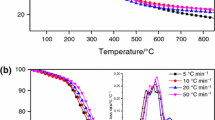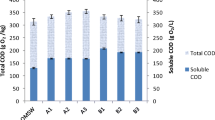Abstract
Anaerobic digestion is a consolidated bioprocess which can be further enhanced by incorporating an upstream pretreatment unit. The olive oil production produces a large amount of solid waste which needs to be properly managed and disposed. Three different pretreatment techniques were evaluated in regard to their impact on the anaerobic biodegradability: manual milling of olive pomace (OP), enzyme maceration, direct enzyme addition, and thermal hydrolysis of two-phase olive mill waste. The Gompertz equation was used to obtain parameters for comparison purposes. A substrate/inoculum ratio 0.5 was found to be the best to be used in anaerobic batch test with olive pomace as substrate. Mechanical pretreatment of OP by milling increases the methane production rate while keeping the maximum methane yield. The enzymatic pretreatment showed different results depending on the chosen pretreatment strategies. After the enzymatic maceration pretreatment, a methane production of 274 ml CH4 g VS −1added was achieved, which represents an improvement of 32 and 71 % compared to the blank and control, respectively. The direct enzyme addition pretreatment showed no improvement in both the rate and the maximum methane production. Steam explosion showed no improvement on the anaerobic degradability of two-phase olive mill waste; however, thermal hydrolysis with no rapid depressurization enhanced notoriously both the maximum rate (50 %) and methane yield (70 %).





Similar content being viewed by others
References
Alburquerque J (2004) Agrochemical characterisation of “alperujo”, a solid by-product of the two-phase centrifugation method for olive oil extraction. Bioresour Technol 91:195–200. doi:10.1016/S0960-8524(03)00177-9
Rincón B, Borja R, Martín MA, Martín A (2009) Evaluation of the methanogenic step of a two-stage anaerobic digestion process of acidified olive mill solid residue from a previous hydrolytic-acidogenic step. Waste Manag 29:2566–2573. doi:10.1016/j.wasman.2009.04.009
Dermeche S, Nadour M, Larroche C, Moulti-Mati F, Michaud P (2013) Olive mill wastes: biochemical characterizations and valorization strategies. Process Biochem 48:1532–1552. doi:10.1016/j.procbio.2013.07.010
Borja R, Rincón B, Raposo F, Alba J, Martín A (2002) A study of anaerobic digestibility of two-phases oli v e mill solid waste (OMSW) at mesophilic temperature. Process Biochem 38:733–742
Taherzadeh MJ, Karimi K (2008) Pretreatment of lignocellulosic wastes to improve ethanol and biogas production: a review. Int J Mol Sci 9:1621–1651. doi:10.3390/ijms9091621
Pérez-Elvira SI, Fdz-Polanco F (2012) Continuous thermal hydrolysis and anaerobic digestion of sludge. Energy integration study. Water Sci Technol 65:1839–1846. doi:10.2166/wst.2012.863
Horn SJ, Estevez MM, Nielsen HK, Linjordet R, Eijsink V (2011) Biogas production and saccharification of Salix pretreated at different steam explosion conditions. Bioresour Technol 102:7932–7936. doi:10.1016/j.biortech.2011.06.042
Frigon J-C, Mehta P, Guiot SR (2012) Impact of mechanical, chemical and enzymatic pre-treatments on the methane yield from the anaerobic digestion of switchgrass. Biomass Bioenergy 36:1–11. doi:10.1016/j.biombioe.2011.02.013
Donoso-Bravo A, Fdz-Polanco M (2013) Anaerobic co-digestion of sewage sludge and grease trap: assessment of enzyme addition. Process Biochem 48:936–940. doi:10.1016/j.procbio.2013.04.005
Ruggeri B, Battista F, Bernardi M, Fino D, Mancini G (2015) The selection of pretreatment options for anaerobic digestion (AD): a case study in olive oil waste production. Chem Eng J 259:630–639. doi:10.1016/j.cej.2014.08.035
Mahdy A, Mendez L, Ballesteros M, González-Fernández C (2014) Enhanced methane production of Chlorella vulgaris and Chlamydomonas reinhardtii by hydrolytic enzymes addition. Energy Convers Manag 85:551–557. doi:10.1016/j.enconman.2014.04.097
Hendriks ATWM, Zeeman G (2009) Pretreatments to enhance the digestibility of lignocellulosic biomass. Bioresour Technol 100:10–18. doi:10.1016/j.biortech.2008.05.027
Angelidaki I, Alves M, Bolzonella D, Borzacconi L, Campos JL, Guwy AJ, Kalyuzhnyi S, Jenicek P, van Lier JB (2009) Defining the biomethane potential (BMP) of solid organic wastes and energy crops: a proposed protocol for batch assays. Water Sci Technol 59:927–934. doi:10.2166/wst.2009.040
Donoso-Bravo A, Pérez-Elvira SI, Fdz-Polanco F (2010) Application of simplified models for anaerobic biodegradability tests. Evaluation of pre-treatment processes. Chem Eng J 160:607–614. doi:10.1016/j.cej.2010.03.082
Latimer GW (2012) Official methods of analysis of AOAC International, 19th edn. AOAC International
Raposo F, De la Rubia MA, Fernández-Cegrí V, Borja R (2012) Anaerobic digestion of solid organic substrates in batch mode: an overview relating to methane yields and experimental procedures. Renew Sustain Energy Rev 16:861–877. doi:10.1016/j.rser.2011.09.008
Raposo F, Borja R, Martín MA, Martín A, de la Rubia MA, Rincón B (2009) Influence of inoculum–substrate ratio on the anaerobic digestion of sunflower oil cake in batch mode: process stability and kinetic evaluation. Chem Eng J 149:70–77. doi:10.1016/j.cej.2008.10.001
González-Fernández C, García-Encina PA (2009) Impact of substrate to inoculum ratio in anaerobic digestion of swine slurry. Biomass Bioenergy 33:1065–1069. doi:10.1016/j.biombioe.2009.03.008
Boulanger A, Pinet E, Bouix M, Bouchez T, Mansour A (2012) Effect of inoculum to substrate ratio (I/S) on municipal solid waste anaerobic degradation kinetics and potential. Waste Manag 32:2258–2265. doi:10.1016/j.wasman.2012.07.024
Kawai M, Nagao N, Tajima N, Niwa Ch, Matsuyama T, Toda T (2014) The effect of the labile organic fraction in food waste and the substrate/inoculum ratio on anaerobic digestion for a reliable methane yield. Bioresour Technol 157:174–180. doi:10.1016/j.biortech.2014.01.018
Chudoba P, Capdeville B, Chudoba J (1992) Explanation of biological meaning of the S(o)/X(o) ratio in batch cultivation. Water Sci Technol 26:743–751
Tekin AR, Coskun Dalgic A (2000) Biogas production from olive pomace. Resour Conserv Recycl 30:301–313
Zhang Y, Banks CJ (2013) Impact of different particle size distributions on anaerobic digestion of the organic fraction of municipal solid waste. Waste Manag 33:297–307. doi:10.1016/j.wasman.2012.09.024
Fernández-Rodríguez MJ, Rincón B, Fermoso FG, Jiménez AM, Borja R (2014) Assessment of two-phase olive mill solid waste and microalgae co-digestion to improve methane production and process kinetics. Bioresour Technol 157:263–269. doi:10.1016/j.biortech.2014.01.096
Quiñones TS, Plöchl M, Budde J, Heiermann M (2011) Enhanced methane formation through application of enzymes: results from continuous digestion tests. Energy Fuels 25:5378–5386. doi:10.1021/ef2009343
Philipp B, Schink B (2000) Two distinct pathways for anaerobic degradation of aromatic compounds in the denitrifying bacterium Thauera aromatica strain AR-1. Arch Microbiol 173:91–96. doi:10.1007/s002039900112
Sutaryo S, Ward AJ, Møller HB (2014) The effect of mixed-enzyme addition in anaerobic digestion on methane yield of dairy cattle manure. Environ Technol 35:2476–2482. doi:10.1080/09593330.2014.911356
Diak J, Örmeci B, Kennedy KJ (2012) Effect of enzymes on anaerobic digestion of primary sludge and septic tank performance. Bioprocess Biosyst Eng 35:1577–1589. doi:10.1007/s00449-012-0748-7
Zhang Y, Wang L, Chen H (2013) Formation kinetics of potential fermentation inhibitors in a steam explosion process of corn straw. Appl Biochem Biotechnol 169:359–367. doi:10.1007/s12010-012-9961-8
Monlau F, Sambusiti C, Barakat A, Quéméneur M, Trably E, Steyer JP, Carrère H (2014) Do furanic and phenolic compounds of lignocellulosic and algae biomass hydrolyzate inhibit anaerobic mixed cultures? A comprehensive review. Biotechnol Adv 32:934–951. doi:10.1016/j.biotechadv.2014.04.007
Jacquet N, Quiévy N, Vanderghem C, Janas S, Blecker C, Wathelet B, Devaux J, Paquot M (2011) Influence of steam explosion on the thermal stability of cellulose fibres. Polym Degrad Stab 96:1582–1588. doi:10.1016/j.polymdegradstab.2011.05.021
Pontoni L, d’Antonio G, Esposito G, Fabriccino M, Frunzo L, Pirozzi F (2015) Thermal pretreatment of olive mill wastewater for efficient methane production: control of aromatic substances degradation by monitoring cyclohexane carboxylic acid. Environ Technol 13–16:1785–1794. doi:10.1080/09593330.2015.1012179
Acknowledgments
This study was funded by Fondecyt Initiation Project No. 11130462 and supported by CIRIC-INRIA-Chile (EP BIONATURE) through Innova Chile Project.
Author information
Authors and Affiliations
Corresponding author
Rights and permissions
About this article
Cite this article
Donoso-Bravo, A., Ortega-Martinez, E. & Ruiz-Filippi, G. Impact of milling, enzyme addition, and steam explosion on the solid waste biomethanation of an olive oil production plant. Bioprocess Biosyst Eng 39, 331–340 (2016). https://doi.org/10.1007/s00449-015-1519-z
Received:
Accepted:
Published:
Issue Date:
DOI: https://doi.org/10.1007/s00449-015-1519-z




